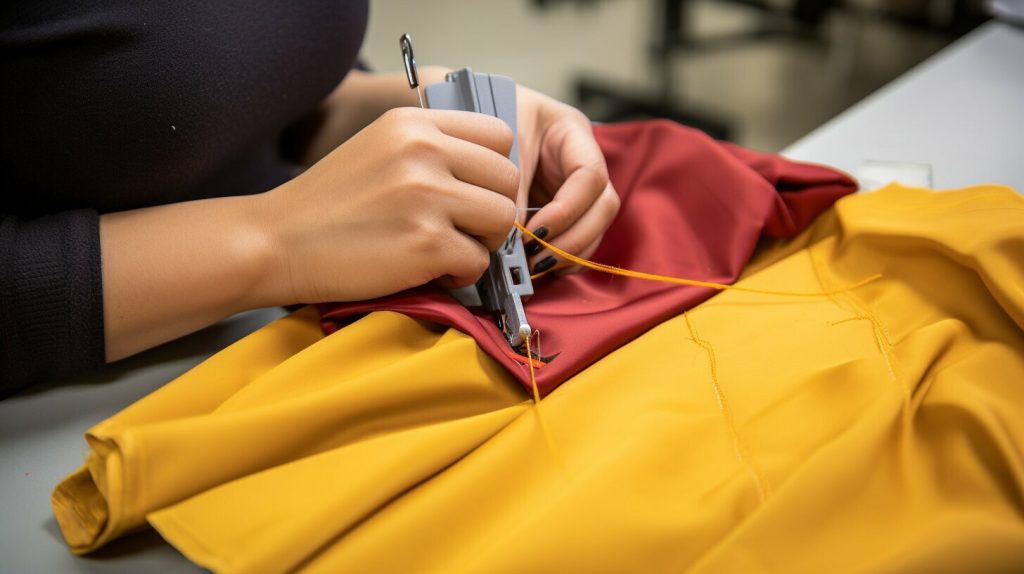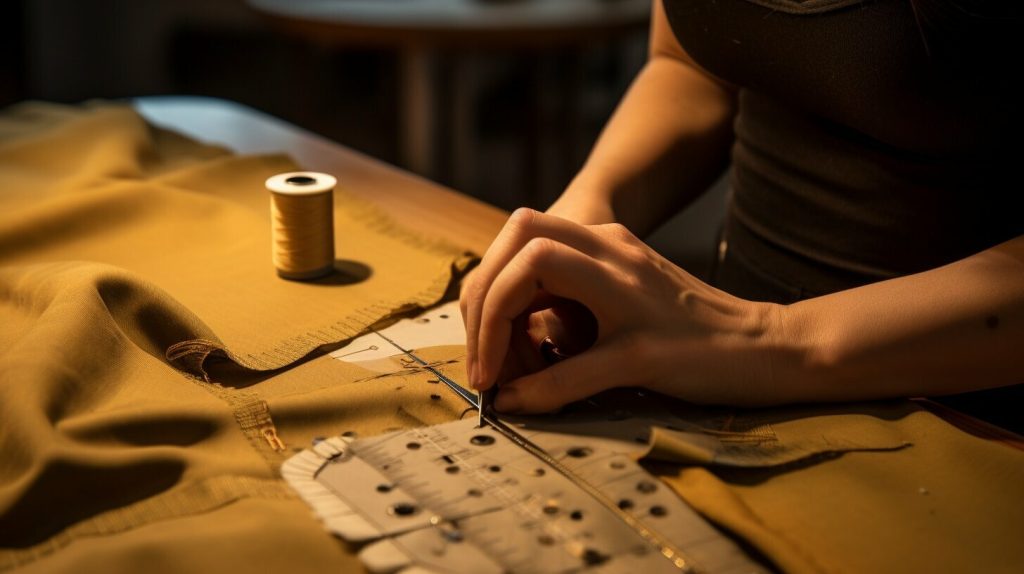
Are you tired of throwing away your favorite leggings because of a small hole? Learn how to sew a leggings hole with this simple step-by-step guide.
Discovering how to sew a hole in leggings is easy with a step-by-step guide. To begin, turn the leggings inside out and smooth out the fabric around the hole. Pinch the fabric together and start stitching on one end of the hole using short stitches. Make sure to include the entire hole in the stitches. Tie a knot using the ends of the thread and cut off the excess. Turning the leggings right side out, inspect and ensure the hole is no longer visible. Additionally, choosing high-quality leggings and proper fit can help prevent holes. Using fabric protectors like Scotchgard can also minimize friction and prolong the lifespan of leggings. Hand sewing is suitable for repairing small holes in stretch fabric like leggings. By following these steps, it’s easy and affordable to fix a hole in leggings and keep wearing them.
- Sewing a hole in leggings is a simple process that can help extend the lifespan of your favorite pair.
- Turn the leggings inside out and smooth out the fabric around the hole before stitching.
- Use short stitches to secure the fabric and make sure to include the entire hole in the stitches.
- Tie a knot at the end and cut off the excess thread for a neat finish.
- Choosing high-quality leggings and using fabric protectors can help prevent holes in the first place.
With this easy guide, you can save money and reduce waste by repairing your leggings instead of discarding them. Keep your favorite pair in great shape and enjoy wearing them for longer.
Easy Step-by-Step Guide for Sewing Leggings Hole
Follow these simple steps to sew a hole in your leggings and give them a new lease on life. To begin, turn the leggings inside out and smooth out the fabric around the hole. This will make it easier to work with and ensure a neater finish.
Next, pinch the fabric together where the hole is located and start stitching on one end of the hole using short stitches. It’s important to use small stitches to ensure a strong and durable repair. Continue stitching along the entire length of the hole, making sure to include the entire hole in the stitches. Once you reach the other end, tie a knot using the ends of the thread and cut off the excess.
Once you’ve finished stitching, turn the leggings right side out and inspect your repair job. Ensure that the hole is no longer visible and that the stitches are secure. If necessary, you can reinforce the stitches by going over them once more.
Choosing high-quality leggings and ensuring they have a proper fit can help prevent holes in the first place. Additionally, using fabric protectors like Scotchgard can minimize friction and prolong the lifespan of your leggings. When it comes to repairing small holes in stretch fabric like leggings, hand sewing is the most suitable method. By following these steps, you can easily and affordably fix a hole in your leggings and continue wearing them for years to come.
To make the repair process even easier, here are a few extra tips and tricks:
- Use a thread that matches the color of your leggings to make the repair less noticeable.
- If the hole is too large to sew, you can patch it up using a small piece of fabric that matches your leggings.
- Consider using a thimble to protect your fingers while stitching, especially if the fabric is thick or tough to work with.
- Practice your stitching technique on a scrap piece of fabric before attempting to repair your leggings.
| Materials Needed: | Tools Needed: |
|---|---|
| Thread | Needle |
| Fabric Scissors | Pins |
| Thimble (optional) |
“Learning how to sew a hole in your leggings can save you money and extend the lifespan of your favorite pair. With just a few simple steps, you can repair those pesky holes and continue enjoying your leggings for years to come.” – Sarah, experienced seamstress
Preventing Leggings Holes and Prolonging Their Lifespan
Discover useful sewing tips and techniques to prevent leggings holes and prolong the lifespan of your beloved leggings. Taking preventive measures can help you avoid the frustration of dealing with holes and save you time and money in the long run. Here are some helpful tips to keep in mind:
- Choose the right needle and thread: When sewing leggings, it’s essential to use the appropriate needle and thread. Opt for a ballpoint needle, which is designed for stretch fabrics like leggings. Pair it with polyester or nylon thread, as these materials provide the necessary strength and flexibility.
- Reinforce stress points: Leggings tend to experience the most strain in certain areas, such as the crotch and inner thighs. To prevent holes from forming, reinforce these stress points by adding extra stitches or using a serger machine for a more secure finish.
- Use fabric patches: If you notice a small hole starting to form, act quickly by applying a fabric patch. Cut a small piece of stretch fabric that matches your leggings and place it on the inside of the hole. Stitch around the edges to secure the patch, preventing the hole from getting bigger.
In addition to these sewing techniques, there are other steps you can take to protect your leggings:
- Avoid harsh washing methods: Washing your leggings inside out on a gentle cycle with cold water can help maintain their integrity. Avoid using harsh detergents or bleach, as these can weaken the fabric and increase the likelihood of holes.
- Invest in high-quality leggings: When shopping for leggings, prioritize quality over price. Look for leggings made from durable materials and with reinforced seams. These leggings are less likely to develop holes and will withstand regular wear and tear.
By following these sewing tips and techniques, you can minimize the occurrence of holes in your leggings and extend their lifespan. Remember, prevention is key, but if a hole does appear, don’t worry – you now have the skills to mend it successfully. By taking care of your leggings and making minor repairs when needed, you can continue to enjoy wearing your favorite pair for a long time to come.
| Needle Type | Thread Material |
|---|---|
| Ballpoint Needle | Polyester or Nylon |
Choosing the Right Leggings and Using Fabric Protectors
Find out how selecting the right leggings and using fabric protectors can make a significant difference in preventing and repairing holes. When it comes to choosing leggings, opt for high-quality materials that offer durability and stretch. Look for leggings made from strong fabrics like nylon or spandex, as they are less likely to develop holes with regular wear. Additionally, leggings with reinforced stitching around high-stress areas like the inner thighs can provide added strength and longevity.
To further protect your leggings, consider using fabric protectors like Scotchgard. These products create an invisible barrier on the fabric, making it more resistant to stains and friction. Apply the fabric protector according to the manufacturer’s instructions, ensuring all areas of the leggings are covered. This extra layer of protection can help minimize wear and tear, reducing the likelihood of holes forming in the fabric.
In addition to selecting the right leggings and using fabric protectors, it’s important to properly care for your leggings. Avoid washing them with abrasive materials or using harsh detergents that can weaken the fabric. Instead, opt for a gentle cycle and mild detergent specifically designed for delicate fabrics. Hang them to dry instead of using a dryer, as high heat can cause damage to the fabric fibers.
| Benefits of Choosing the Right Leggings and Using Fabric Protectors |
|---|
| Increases the lifespan of your leggings |
| Minimizes the risk of holes and tears |
| Protects against stains and friction |
| Preserves the quality and appearance of the fabric |
By taking these measures, you can prolong the lifespan of your leggings and reduce the need for repairs. However, even with the best precautions, holes can still occur. When faced with a hole in your leggings, don’t fret! With a little sewing know-how and the right techniques, you can easily mend the damage and continue enjoying your favorite pair of leggings.
Remember, hand sewing is best for repairing small holes in stretch fabric like leggings. By following the step-by-step guide in the previous sections, you’ll be able to sew a hole in your leggings like a pro. Now you can confidently wear your favorite leggings without worrying about unsightly holes or the need to replace them. Take care of your leggings, choose the right fabric, and use fabric protectors, and you’ll enjoy long-lasting leggings that stay in great shape.
Conclusion
Sewing a hole in your leggings is a valuable skill that can extend the life of your favorite garments. With the easy step-by-step guide provided, you can confidently repair any holes and keep your leggings in great condition for longer.
To begin, turn the leggings inside out and smooth out the fabric around the hole. Pinch the fabric together and start stitching on one end of the hole using short stitches. Make sure to include the entire hole in the stitches. Tie a knot using the ends of the thread and cut off the excess.
Turning the leggings right side out, inspect and ensure the hole is no longer visible. By following these simple steps, you can mend your leggings and continue to wear them with confidence.
Additionally, choosing high-quality leggings and ensuring the proper fit can help prevent holes in the first place. Investing in leggings made from durable materials will ensure they withstand everyday wear and tear. Furthermore, using fabric protectors such as Scotchgard can minimize friction and prolong the lifespan of your leggings.
Remember, hand sewing is the best method for repairing small holes in stretch fabric like leggings. With a little practice, you’ll become proficient in mending your leggings and save money by avoiding costly replacements.
So, next time you notice a hole in your leggings, don’t panic! Use the step-by-step guide provided and take control of extending the life of your favorite garments. Happy sewing!
FAQ
How do I sew a hole in leggings?
To sew a hole in leggings, start by turning them inside out and smoothing out the fabric around the hole. Pinch the fabric together and begin stitching on one end of the hole using short stitches. Make sure to include the entire hole in the stitches. Tie a knot using the ends of the thread and cut off the excess. Turn the leggings right side out and inspect to ensure the hole is no longer visible.
How can I prevent holes in leggings?
To prevent holes in leggings, it’s important to choose high-quality leggings and ensure they fit properly. Additionally, using fabric protectors like Scotchgard can minimize friction and prolong the lifespan of your leggings.
What type of sewing is suitable for repairing small holes in leggings?
Hand sewing is suitable for repairing small holes in stretch fabric like leggings. It allows for better control and flexibility when stitching.
Can I use these steps to repair holes in other clothing items?
While these steps are specifically tailored for repairing holes in leggings, you can apply similar techniques to mend small holes in other clothing items made from stretch fabric. Adjust the stitching method and thread color accordingly to achieve optimal results.






